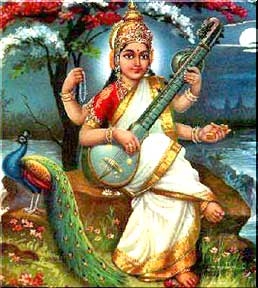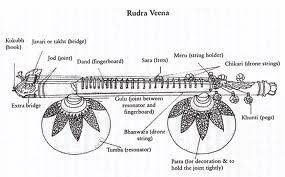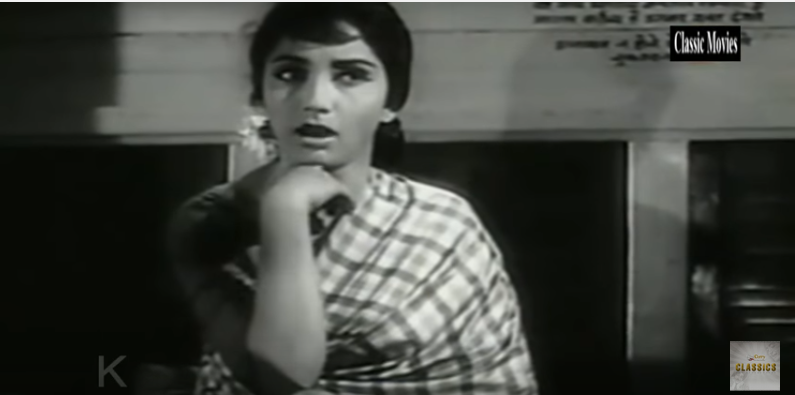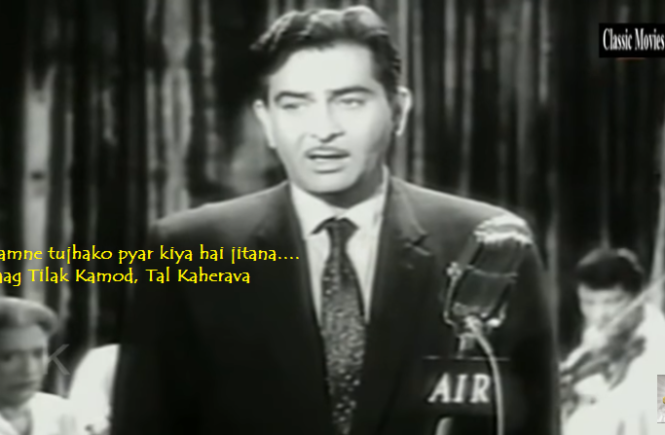Raaga Based Song of the Day: Hamne tujhako pyar kiya hai jitna…
Raag Tilak Kamod, Tal Kaherava
The other day, commenting on my post on Mukesh, a friend remarked that he hasn’t sung many raaga based songs. This is not really correct. Shankar Jaikishan have composed hundreds of raaga based songs and in most of these the male voice has been that of Mukesh. These also include their (Jaikishan’s) favourite raaga: Bhairavi. I checked up this raag, Tilak Kamod, that is. It appears that many of the songs in this raaga have been sung by Mukesh.
We have completed forty-seven days of Raaga Based Songs of the Day. Our first post in the series was titled ‘Raaga Based Song Of The Day #1’ and the song was a Mohammad Rafi and Lata Mangeshkar song from the 1970 Shakti Samanta movie Pagla Kahin Ka: Tum mujhe youn bhula na paoge. It is in Raag Jhinjhoti, Tal Kaherava.
Our forty-seventh post was titled ‘Raaga Based Song Of The Day #47‘ and the song was a Lata Mangeshkar song from the 1955 Amiya Chakravarty movie Seema: Man mohana bade jhoothe. It is in Raag Jaijaiwanti, Tal Ektal.
This blog has a number of posts on Raaga based songs in Hindi movies titled similarly; for example: ‘The Best Raaga Based Songs in Hindi Movies – Raaga Bhairavi – Part I‘.
In the last forty-seven days of sharing Raaga based songs of the day, I have given you songs based on Raag Jhinjhoti, Gara, Bhimpalasi, Madhuvanti, Shivaranjani, Bihag, Pahadi, Sarang, Pilu, Bhairavi, Khammaj, Charukesi, Kalyan or Yaman, Desh, Malgunji, Kirwani, Kedar, Bageshri, Megh Malhar, Bhupali, Ahir Bhairav, Malkaush, Adana, Kafi, Rageshri, Jaunpuri, Tilang, Janasammohini, Chayanat, Shuddha Kalyan, Gaur Sarang, Jogiya, Asavari, Maru Bihag, Durga, Lalit, Puria Dhanashri, Bhinna Sahdja, Sohani, Multani, Patdeep and Jaijaiwanti. The only two raag that has been repeated so far are Pahadi, the raaga of my home place in the Himalayas, and Maru Bihag.
Today, I give you a song in Raag Tilak Kamod, Tal Kaherava.
However, first, lets take up the value added learning of today. Today, we shall learn about Veena.
 Veena is one of the oldest of Indian musical instruments. If you look at a picture of Goddess Saraswati, the goddess of learning, you see her sitting with a Veena. It is so ancient that the word Veena in Sanskrit used to genrecally mean any plucked stringed instrument. Veena is mentioned in the Rigveda, Samaveda and other Vedic literature such as the Shatapatha Brahmana and Taittiriya Samhita. In the ancient texts, the sage Narada is credited with inventing the Veena and even his pictures show him carrying Veena.
Veena is one of the oldest of Indian musical instruments. If you look at a picture of Goddess Saraswati, the goddess of learning, you see her sitting with a Veena. It is so ancient that the word Veena in Sanskrit used to genrecally mean any plucked stringed instrument. Veena is mentioned in the Rigveda, Samaveda and other Vedic literature such as the Shatapatha Brahmana and Taittiriya Samhita. In the ancient texts, the sage Narada is credited with inventing the Veena and even his pictures show him carrying Veena.
 The construction of Veena varies between the Hindustani music and Carnatic Music. In Hindustani music, it is a stick zither about 3.5 to 4 feet. It has a hollow body and two large resonating gourds under each end. There are a total of seven strings; four main strings which are melody type, and three auxiliary drone strings. To play, the musician plucks the melody strings downward with a plectrum worn on the first and second fingers, while the drone strings are strummed with the little finger of the playing hand. The musician stops the resonating strings, when so desired, with the fingers of the free hand. The veena has been generally replaced with the sitar in north Indian performances.
The construction of Veena varies between the Hindustani music and Carnatic Music. In Hindustani music, it is a stick zither about 3.5 to 4 feet. It has a hollow body and two large resonating gourds under each end. There are a total of seven strings; four main strings which are melody type, and three auxiliary drone strings. To play, the musician plucks the melody strings downward with a plectrum worn on the first and second fingers, while the drone strings are strummed with the little finger of the playing hand. The musician stops the resonating strings, when so desired, with the fingers of the free hand. The veena has been generally replaced with the sitar in north Indian performances.
In the Carnatic music design, Veena is a long-necked, pear shaped lute. It has a pear shaped wooden piece in place of the lower gourd of the Hindustani music Veena. It too, however, has 24 frets, four melody strings, three drone strings, and played quite similar. Unlike, in Hindustani music, Veena continues being an important and popular stringed instrument in Carnatic music.
Veena strings can produce pitches in full three octave range.
Veenas are of different types. Some of these are:
- Rudra Veena is a fretted veena, with two large equal size tumba (resonators) below a stick zephir.
- Saraswati Veena is similar to Rudra Veena with the two resonators being of different sizes.
- Vichitra Veena does not have frets. It sounds close to humming human singer.
- Tritantri (3 string) Veena, now called Sitar (a Persian word meaning three strings).
- Saradiya Veena, now called Sarod.
- Pinaki Veena, related to Sarangi.
- Kachapi Veena, now called Kachua Sitar.
- Others such as Shatatantri Veena (Santoor), Gayatri Veena (with one string only) and Saptatantri Veena.
As I mentioned, today’s song is composed in Raag Tilak Kamod, Tal Kaherava.
Tilak Kamod belongs to Khammaj Thaat in Bhatkhande’s system of raagas. Its Jati is Shadava-Sampoorna, ie, six notes in Aaroha (Dha is excluded) and all seven notes in Avaroha. All the notes are shuddha except Ni which is sometimes Komal. Indeed, use of Komal Ni is the characteristic of Khammaj Thaat.
Raag Desh has some similarities with Tilak Kamod, especially when the latter also includes flat Ni.
A large number of compositions are based on this raag. These include compositions in genres such as: dhrupad, dhamar, sadra, khayal as well as semi-classical genres such as thumri and dadra and popular forms like ghazal.
Some of the popular songs composed in this raaga are:
| 1. 2. 3. 4. 5. 6. 7. 8. 9. 10. 11. 12. 13. 14. 15. 16. 17. 18. 19. 20. 21. 22. 23. 24. |
More Baalapan Ke Ab Raja Bhae Koi Roke Usse Man Bhooli Kathaen Dekho jee Mora Man Re Hari Ke Tere Pyar Ka Kisko Khabar Thi Ae Ri Jaane Na Sharabi Sharabi Yeh Jia Jarat Rahat Yeh Neer Kahan Se Thandi Thandi Saawan Ki Tumhare Bina Jeena Badi Der Se Megha Jhoola Kinne Dara Re Badaria Baras Gayi Mujhe Mil Gayi Hai Sada Khush Rahe Tu Na Shikwa Hai Koi Humne Tumko Pyar Kiya Hai Jao Re Jogi Chhed Diye Mere Sakhi Ri Sun |
Tansen Tansen Sindoor Dooosri Shaadi Nau Bahar Musafir Dhool Ka Phool Devdas Chitralekha Noorjahan Godaan Prem Parbat Jaagte Raho Bhumika Namkeen Umrao Jaan Moorti First Love Pyar Ka Sagar Amar Dulha Dulhan Amrapali Raagini Miss Mary |
Khursheed, K. L. Saigal Khursheed Ameer Bai Shamshaad Lata Lata Lata, Mahendra Talat Asha, Usha Suman Kalyanpur Mukesh Lata Asha Preeti Sagar Asha Shahida Mukesh, Hamida Mukesh Mukesh Lata Lata, Mukesh Lata Amanat Ali, Fateh Ali Lata, Asha |
Today’s song is from the 1964 Ravindra Dave movie Dulha Dulhan starring Raj Kapoor and Sadhana. The movie had beautiful songs penned by Indeevar and composed by Kalyanji Anandji:
| 1 | “Mujhe Kahte Hai Kallu Qawal” | Mukesh, Lata Mangeshkar |
| 2 | “Main Tera Hoon Dulha Tu Meri” | Mukesh, Lata Mangeshkar |
| 3 | “Hamne Tujhko Pyar Kiya Hai (Male)” | Mukesh |
| 4 | “Hamne Tujhko Pyar Kiya Hai (Female)” | Lata Mangeshkar |
| 5 | “Jo Pyar Tune Mujhko Diya Tha” | Mukesh |
| 6 | “Jumme Ki Raat Ho Ya Din” | Mukesh, Lata Mangeshkar |
| 7 | “Piya Kheenche Huye Bandhe Huye” | Kamal Barot, Lata Mangeshkar |
| 8 | “Tum Sitam Aur Karo” | Mukesh |
The story revolves around Chanda (Sadhana) who lives a wealthy lifestyle in Jaipur along with her father, Thakur Dharam Singh (KN Singh), and mom. Since she is of marriageable age, her dad wants her to get married to a wealthy male of his choice, but she dislikes him. Arguments ensue at home and her dad slaps her, she falls down and passes out. When she regains her senses she finds herself in a hospital in Bombay with her dad at her bedside, who tells her that she was unconscious for 3 days, apologizes and promises never to pressurize her to get married. She forgives him and they return home. A few days later she gets a visitor, a male Akashwani singer by the name of Raj Kumar (Raj Kapoor), who claims to be her husband, calls her by the name of Rekha, and wants her to accompany him back to Bombay where he lives in a Chawl along with a two-bit Bollywood actor, Bansi (Agha).

Please enjoy Mukesh sing a song composed by Kalyanji Anandji in Raag Tilak Kamod, Tal Kaherava, on the lyrics of Indeevar: Hamne tujhako pyar kiya hai jitna….
Hamane tujhako pyaar kiyaa hai jitanaa
Kaun karegaa itanaa -2
Aa.Nkh churaaii Thes lagaaii dil bhii tuune to.Daa
Laakh chhupaayaa tuune daaman ham ne saath na chho.Daa
Tere karam ko tere sitam ko sahate rahe.n ham jitanaa
Kaun karegaa itanaa…
Tuu hii tuu hai in aa.Nkho.n me.n aur nahii.n koii duujaa
Tujh ko chaahaa tujh ko saraahaa aur tujhe hii puujaa
Tere dar ko maan ke ma.ndir jhukate hai.n ham jitanaa
Kaun karegaa itanaa…
Tere jaisaa saathii jisame.n tere jaisaa dil hai
Taakh burii ho duniyaa phir bhii jiine ke qaabil hai
Tere saath jiine kii khaatir miTate rahe ham jitanaa
Kaun karegaa itanaa…
Ham ne tujh ko pyaar kiyaa
Ham ne tujh ko pyaar kiyaa hai jitanaa
(kaun karegaa itanaa)-2
Roye bhii to dil hii dil me.n, mahafil me.n musakaaye
Tujh se hii ham teraa ye Gam, baraso.n rahe chhupaaye
(Pyaar men tere chhupake chhupake)-2
Jalate rahe ham jitanaa
(Kaun jalegaa itanaa)-2
Ham ne tujh ko pyaar kiyaa hai jitanaa
(Kaun karegaa itanaa)-2
Pyaar pe mere naaz tumhe thaa, yaad karo vo nazaaraa
Haath pe apane likh lete the, jab tum naam hamaaraa
(Terii adaa ke bhole pan pe)-2
MiTate rahe ham jitanaa
(Kaun miTegaa itanaa)-2
Ham ne tujh ko pyaar kiyaa hai jitanaa,
(Kaun karegaa itanaa)-2
We have intended to learn about Raaga based music whilst we entertain ourselves with Raaga based songs. So, lets, once again, take stock of our collective learning so far:
- On the first day we learnt about the Raaga system devised by Pandit Vishnu Narayan Bhatkhande, which is the prevalent system in Hindustani Classical Music and based on ten Thaats.
- On the second day we learnt about Tal or Taal.
- On the third day we learnt about characteristics of Raagas that included Swar, Jati, Thaat, Arohana and Avarohana, Vadi, Samvadi and Pakad.
- On the fourth day, we learnt about Sargam.
- On the fifth day, we learnt about notations used in Indian classical music or simply Swar Lipi.
- On the sixth day, we learnt about the Ras (sentiments) that Raagas evoke.
- On the seventh day, we learnt about various types of Swar: Shuddha, Achal, Vikrut, Komal and Teevra.
- On the eighth day, we learnt the parts of a composition in Indian Classical Music.
- On the ninth day, we learnt the names of some of the popular instruments used in Indian Classical Music.
- On the tenth day, we learnt about the sources of names of Raagas.
- On the eleventh day, we learnt about why Bhairavi is the first raag to be taught to beginners and also why it is the last in a performance.
- On the twelfth day, we learnt about Khammaj Thaat.
- On the thirteenth day, we learnt about Tal Punjabi Theka or Sitarkhani.
- On the fourteenth day, we learnt about Alap.
- On the fifteenth day, we learnt about List of Raagas (Raagmala) in my favourite book: Sri Guru Granth Sahib.
- On the sixteenth day, we learnt about tips for raaga identification.
- On the seventeenth day, we learnt the basics of Gharana system.
- On the eighteenth day, we learnt about Filmi Sangeet.
- On the nineteenth day, we learnt about the commonest Tal in Raagas: Tintal.
- On the twentieth day, we learnt about the Kafi Thaat.
- On the twenty-first day, we learnt a little more in detail about the classification of Raagas.
- On the twenty-second day, we learnt the essential differences between Bhairavi and Bhairav.
- On the twenty-third day, we learnt a little more in detail about the Jati or Jaati of a raaga.
- On the twenty-fourth day, we learnt details of Thaat Bilawal, the most basic thaat in the Bhatkhande’s system of raagas.
- On the twenty-fifth day, we learnt about Tintal.
- On the twenty-sixth day, we learnt in detail about the Raaga – Samay linkage.
- On the twenty-seventh day, we learnt about Lehar.
- On the twenty-eighth day, we learnt about the history of the Hindustani Music.
- On the twenty-ninth day, we learnt about Dhrupad.
- On the thirtieth day, we learnt about Rupaktal that I was introduced to, a few months back, by my friend Anand Desai.
- On the thirty-first day, we learnt about Khayal.
- On the thirty-second day, we learnt about Thumri.
- On the thirty-third day, we learnt about Tappa.
- On the thirty-fourth day, we learnt about Tarana.
- On the thirty-fifth day, we learnt about Tal Dipchandi (Moghali).
- On the thirty-sixth day, we learnt about Tabla.
- On the thirty-seventh day, we learnt about Kirtan.
- On the thirty-eighth day, we learnt about Pakhawaj.
- On the thirty-ninth day, we learnt about Hori.
- On the fortieth day, we learnt about Dadra.
- On the forty-first day, we learnt about Kajri.
- On the forty-second day, we learnt about Chaiti.
- On the forty-third day, we learnt about Sarangi.
- On the forty-fourth day, we learnt about Shehnai.
- On the forty-fifth day, we learnt about Sarod.
- On the forty-sixth day, we learnt about Bansuri.
- On the forty-seventh day, we learnt about Ektal and Tanpura.
- And today, on the forty-eighth day, we learnt about Veena.
There is much more still to be learnt and enjoyed.
Please stay tuned!

Beautiful song by Mukesh . Raag Tilak Kamod ::::: six notes in Aaroha (Dha is excluded) and all seven notes in Avaroha …….. What how to locate this pattern in the song … is the main question.
Enlightened to know Veena was created by Narada Muni .
Thank you Jaswant. One way to locate these is to practice listening to the Sargam and then apply it to the song. It is difficult in the beginning but once you master it, it becomes easier.